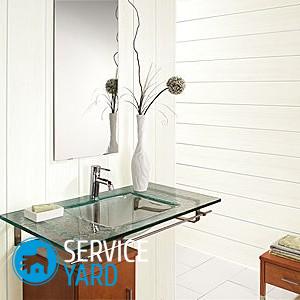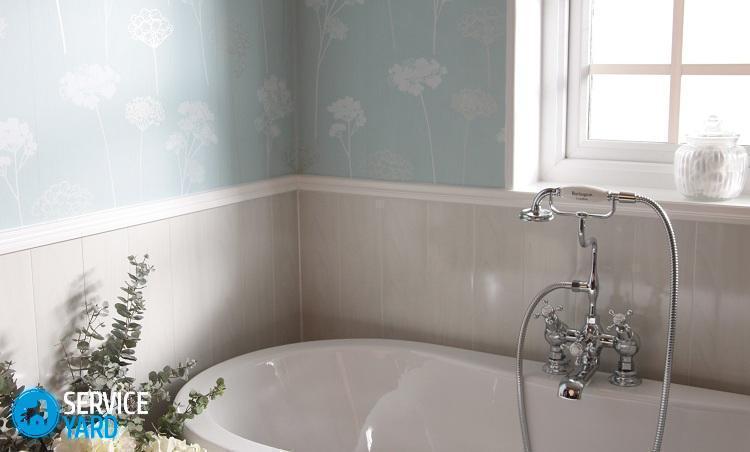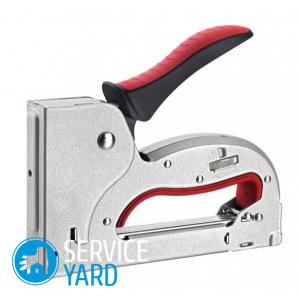Do-it-yourself wall covering with plastic panels

Plastic is one of the most used materials in modern construction. Therefore, PVC technology products are available in a huge assortment. As for the decoration of the walls, wide panels are used for these purposes, which can be selected according to the color, pattern and even the properties that they should have. If you decide to decorate the surfaces with such a finishing material, we will tell you how to do the wall sheathing with plastic panels with your own hands, so that they lie flat and last for more than one year.
to contents ↑The whole truth about plastic
Before starting work, you should first evaluate the characteristics of this finishing material and debunk all the myths that are associated with it.
The true facts:
- Plastic is completely harmless. Thanks to modern technology, PVC panels, which are designed for decoration, have become completely harmless to humans. This is due to the fact that now in the production of this material, such chemical components as asbestos and cadmium are not used. In addition, due to this, the price position of plastic in the building materials market has become much lower.
- Aesthetics. Thanks to a huge range of different colors, patterns and textures, the wall, sheathed with plastic panels, looks stylish and original.
- Universality. Plastic panels are conveniently used in those places where the use of other finishing materials is problematic or impossible, for example, when facing irregularly shaped walls or various architectural delights.
- Reliability. Such material is quite capable of withstanding a TV, sconce or picture.
- Organic Plastic, regardless of its texture and color, looks organically with various ventilation grilles, split systems and sockets.
- Durability. Despite the fact that plastic is a fairly lightweight material that can be pierced, with proper care it will last more than one decade and is able to withstand moisture and different temperatures.
Shouting Myths about Plastic
Today, there are many “myths” about this material, for example:
- Plastic panels do not require special conditions from the wall surface. As for the plastic itself, it is rather undemanding material. But the crate should already occur on a surface cleaned from the old finishing material and on an absolutely even wall.
- Lining with plastic panels is very light and does not require much effort. Indeed, the sheathing process is simple, but efforts and attentiveness will have to be applied in order for the finished result to turn out to be qualitative and even.
- Hygiene of this material. Unfortunately, this is not true. Plastic has no moisture and vapor permeability. Therefore, walls that are sheathed with plastic panels simply do not breathe.
Important! Plastic panels are best used for lining the bathroom, kitchen, balconies or loggias. It is not recommended to carry out such wall decoration in the bedroom, nursery and living room.
- Unattractive to insects. Due to the fact that the plastic inside is hollow, various spiders and other insects can settle in it.
Important! Plastic panels, when properly installed, are airtight, and if you do not break it, then nothing bad will happen, and “uninvited guests” will not settle inside such a finish.
- Flammability of plastic. Such a finishing material does not ignite from heat or matches. However, if the room is completely lit, then the plastic panels are also exposed to fire, and toxic substances are released.
Types of PVC panels
Today, plastic panels are divided into the following types:
- Reiki They are assembled in a single design using grooves.
Important! In order to visually enlarge a room using plastic battens, wall panels need to be installed vertically.
- PVC panels imitating tiles.
- Sheet materials. They are similar in appearance to plywood.
Such finishing material is mounted on special adhesive mixtures or fixed with small self-tapping screws, and the joints are coated at the end of the work.
to contents ↑Important! When choosing a material for wall cladding with plastic, first pay attention to the color scheme and pattern.
How to sheathe walls with PVC panels?
For decorative wall decoration, this material should be stocked with special tools. You will need:
- Jigsaw or circular saw;
Important! It is best to opt for a saw. This is due to the fact that when working with a jigsaw, it stumbles on stiffeners - the cut at the end can be wavy.
- Miter box for jigsaw with angles of 90 and 45 degrees;
- Staple gun - you will need it if the lining is made on a wooden crate;
- Rubber mallet;
- Stucco spatula.
Important! When choosing a stapler for working with plastic, pay attention to the fact that the slot of the extruded staple is located as close to the toe as possible. This will greatly simplify installation.
Preparatory work
Before you make the wall sheathing with panels, first you need to make a crate - the manufacture of the main frame. This will make it possible in the future to easily replace panels and provide reliable fasteners. For the crate of the walls, wooden bars or a metal profile are most often used.
Important! Small cells, which are located directly behind the structure, can also be used for laying insulating materials.
Such a crate is attached to the wall surface using clamps or self-tapping screws in dowels. In order for the frame to be durable and you have no problems installing plastic panels, the crate process must be carried out following the following sequence of actions:
- Use the level to make a preliminary markup.
- Place the transverse battens of the battens at a distance of 30-50 centimeters from each other.
Important! Pay attention to the fact that the lowest rail should be located so that it is in maximum contact with the floor, and the upper - with the ceiling.
- In order to hide the corner joints, install the guides and fittings.
Important! If the wall is not completely straight, you can put a piece of wood or some other durable material under the rail.
We mount PVC panels
In order to do the wall cladding with plastic panels with your own hands, you must adhere to the following algorithm of actions:
- Fix the start and finish profile of the structure vertically.
- Bring the first board into the upper profile, slightly bend it.
- Put the board fully in place, fix it with brackets or self-tapping screws.
Important! So that the walls in the end turned out to be smooth and without gaps, do not forget to use the construction level.
- Install the remaining PVC panels in the same way.
Important! The cheap profile from such manipulations may remain bent or crack along the edge of the corner. In order to fix such a defect, it is necessary to heat a deformed place with a household hair dryer and press it with a cold iron with pressure.
- From the side of the large mounting shelf, trim the last board to the size you need. After - get her under the niche reserved for her.
- Hide the cropped part. To do this, gently bend the shelf of the finishing profile and place it under the board.
How to care for PVC panels?
After you have finished wall decoration with plastic, it is very important to ensure that this material is properly maintained. This will significantly extend its aesthetic appearance and long life.
The basic rules for caring for walls with PVC panels:
- Such a surface should be washed with an exceptionally soft cloth.
- Try to use detergents for washing without the presence of an abrasive or solvent.
Important! The most acceptable option for the care of plastic wall cladding is considered a normal soap solution.
- At the end, the surface should be wiped with plain clean water.
Tips & Tricks
Despite the fact that the plastic for wall sheathing is quite easy to install, there are still nuances, non-observance of which will lead to a significant reduction in the operational life of this finish and the appearance of gaps due to uneven surfaces:
- It is impossible to work with cold material, therefore, if plastic is brought from the street, it must be allowed to stand for 30-60 minutes before the start of the process.
Important! Do not install PVC panels in rooms with temperatures below 20 degrees.
- The crate should be divided so that there is a distance of about 50 centimeters between the rails.
- For better ventilation, it is necessary to make cuts in the rails themselves.
- Despite the fact that PVC panels are a rather unpretentious finishing material, nevertheless, before starting work, the walls should be cleaned of old finishing material and debris.
- If there is a need to cut the panels into pieces, this should be done “face” down.
- The protective film can only be removed after the installation is complete.
- If you fasten the panels to the crate, it is best to use special thermal washers to fix them. This is a fairly reliable mount that can withstand the effects of high temperatures.
- If the PVC panel is with a pattern, then installation should begin from the left corner, gradually moving to the right.
- To lay the wires, it is necessary to install the grooves of the plastic strips before starting the installation work.
Stock footage
Installing PVC panels is a fairly simple and not too laborious process. Nevertheless, even such a simple finishing material in work requires compliance with certain rules during its installation. Putting into practice our advice, you can without special physical effort and material costs to produce decorative wall cladding with plastic. As a result, you get perfectly smooth walls, a stylish design and a warm atmosphere of comfort in your home.






